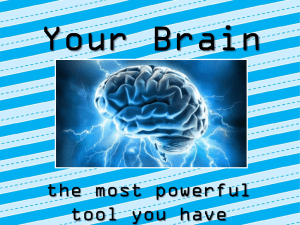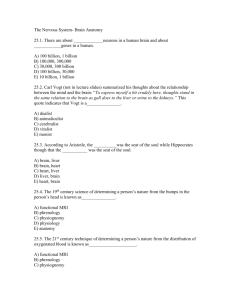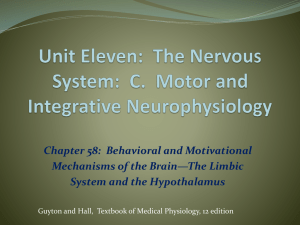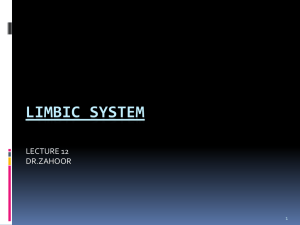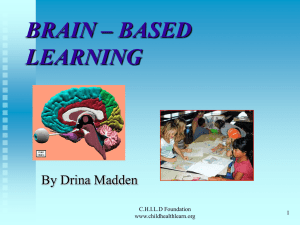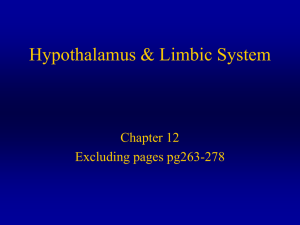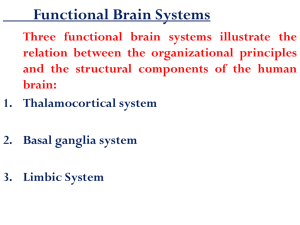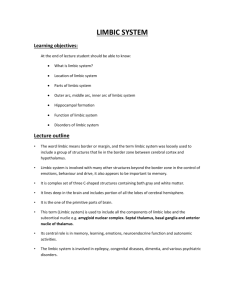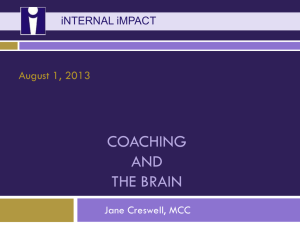limbic system (2)
advertisement
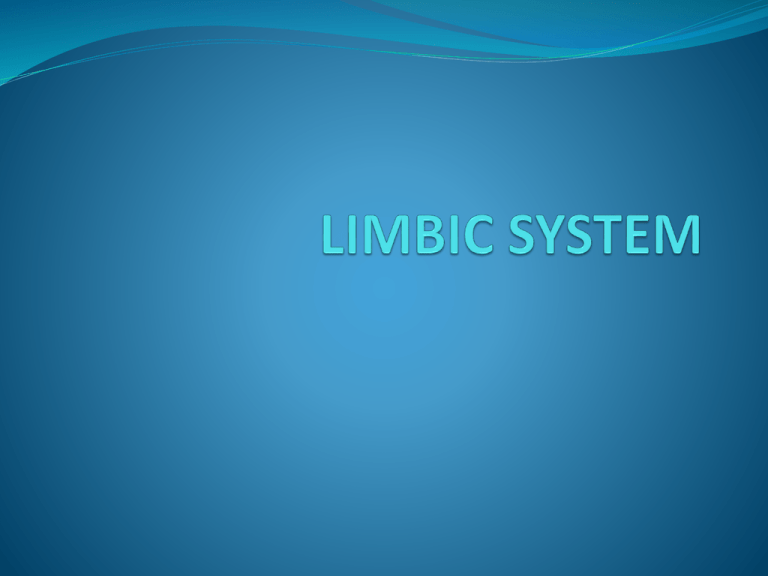
LIMBIC SYSTEM Limbic:border Refers to a ring of gray matter on the medial aspect of the cerebral hemispheres. Network of structures is associated with emotions, basic survival and sociosexual behavioral patterns, motivation, and learning. Motivation is the ability to direct behavior toward specific goals. Homeostatic drives sensation of thirst,hunger. Components •Amygdaloid body •Hippocampus (“seahorse”) •Cingulate gyus •Parahippocampal gyrus •Hypothalamus •Mamillary bodies •Anterior nucleus of thalamus •Medial forebrain bundle Hypothalamus: Major part Vegetative roles Behavioral control governs the involuntary internal responses of various body systems in preparation for appropriate action to accompany a particular emotional state. For example, the diversion of blood to skeletal muscles that occur in anticipation of attack or when angered. Preparatory changes in the internal state require no conscious control. Concept of reward and punishment center Electrical self-stimulation and reward Stimulation in the lateral hypothalamus Stimulation in the ventromedial nucleus Concept of reward or punishment center. Anterior nucleus of thalamus Connections: Mammillothalamic tract,cingulate gyrus and hypothalamus Functions: Emotional tone i-e attitude,mechanism of recent memory. Mamillary bodies Relay for impulses from amygdalae and hippocampi, via the mamillo-thalamic tract to the thalamus. Mammillotegmental tract: terminates in reticular formation of mid brain. They, along with the anterior and dorsomedial nuclei in the thalamus, are involved with the processing of memory. They are believed to add the element of smell to memories. Lesion:anterograde amnesia. Dorsomedial nucleus of thalamus Prefrontal cortex, hypothalamus,other thalamic nuclei. Integration of somatic,visceral,olfactory information and relation to subjective feelings and emotional states. Hippocampus Hyperexcitable:Prolonged discharges with slight stimulus 3 layered structure Involved in sensations Almost any type of sensory experience causes activation of at least some part of the hippocampus. Seizures and hallucinations:focal epileptic seizures with psychomotor effects. Roles Learning(bilateral lesion,cant learn even names) Memory(working memory,consolidation of memory, declarative memory functions) Evolutionary role (smell things to eat) Decision making for life and death It helps control corticosteroid production. It also has significant contribution to understanding spatial relations within the environment. Lesion Anterograde amnesia. Lobes are removed for treatement of epilepsy. Regions of the Amygdala Large basolateral region: Provides direct input to basal ganglia and motor system. Small corticomedial group of nuclei: Related to olfactory cortex especially in lower animals. Amygdala stimulation produces emotional behaviors through subcortical pathways Functions of the Amygdala behavioral awareness areas project into the limbic system one’s current status in relation to both surroundings and thoughts. make the person behavioral response appropriate for each occasion Relate environmental stimuli to coordinated behavioral autonomic and endocrine responses seen in speciespreservation. Responses include: Feeding and drinking fighting behavior Mating and maternal care Responses to physical or emotional stresses Limbic cortex Cerebral association area for control of behavior. Two-way communication and association linkage between the neocortex and the lower limbic structures. most poorly understood portion. Essentially all behavioral patterns can be elicited by stimulation of specific portions of the limbic cortex. Ablation of some limbic cortical areas can cause persistent changes in an animal’s behavior. Ablation of the Posterior Orbital Frontal Cortex Insomnia associated with intense motor restlessness. Function: The orbital frontal lobes act as the Senior Executive of the social-emotional brain and exert tremendous inhibitory as well as expressive influences on emotion and generalized arousal through its massive interconnections with various limbic nuclie, the dorsal medial nucleus of the thalamus and the reticular formation. When the orbital area is injured all aspects of emotional and inhibitory behaviors may be compromised, and patients may display disinhibition, manic-excitement, and internal utilization behaviors (increased sexuality, orality).With complete destruction of the orbital area, emotional and social functioning is abolished, but with less extensive damage, rather than a loss of emotion there is a loss of emotional control. cortical regions of the limbic system occupy intermediate associative positions : Anterior temporal cortex: gustatory and olfactory behavioral associations. Parahippocampal gyri:complex auditory associations ,complex thought associations derived from Wernicke’s area of the posterior temporal lobe. Middle and posterior cingulate cortex: sensorimotor behavioral associations occur. Ablation of the Anterior Cingulate Gyri and Subcallosal Gyri Portions of the limbic cortex that communicate between the prefrontal cerebral cortex and the subcortical limbic structures. Releases the rage centers of the septum and hypothalamus from prefrontal inhibitory influence. Animal can become VIOLENT and much more subject to fits of rage than normally. Roles of prefrontal cortex conscious awareness of emotional feelings prefrontal and limbic association areas, are important in conscious learned control of innate behavioral patterns. formulates plans and guides behavior, suppressing amygdala-induced responses that may be inappropriate for the situation at hand Medial forebrain bundle Extends from the septal and orbitofrontal regions to the brain stem reticular formation. Communication system between limbic system and brainstem. Roles of reticular formation: mediate the orders of hypothalamus,arousal. Higer centers to connect the limbic system and hypothalamus with the outer world neural mechanisms necessary for implementing the appropriate skeletal muscle activity required to approach or avoid an adversary, participate in sexual activity, or display emotional expression. reinforce, modify, or suppress basic behavioral responses so that actions can be guided by planning, strategy, and judgment based on an understanding of the situation. Pathologies (lesions) Voracious appetite:very hungery Increased (perverse) sexual activity Docility: Loss of normal fear/anger response,very calm and easy to control Memory loss: Damage to hippocampus portion Rage the slightest provocation causes an immediate savage attack. expected from an animal being severely punished. rage phenomenon is held in check mainly by ventromedial nuclei hippocampi anterior limbic cortex (anterior cingulate gyri and subcallosal gyri) Placidity and Tameness Tranquil,calmness reward centers are stimulated Neurotransmitter Systems and the Limbic System Dopamine 2. Noradrenergic system 3. Cholinergtic system 4. Serotonin 1. No functional signifance,just historical Functions of limbic system The hypothalamus plays an important role in generating emotional behaviors…but The amygdala has been implicated in playing a prominent role in integrating information and coordinating emotional behaviors in response to sensory stimuli, events, and memories. These findings were demonstrated in: Fear conditioning studies in rodents Monkey studies (Kluver-Bucy) Human neuroimaging and lesion studies Studies of memory modulation by hormones in lower animals. Reward processing occurs in distinct brain circuits. Stimulation of these circuits can provide powerful reinforcement signals. Dopaminergic neurons in the ventral tegmental area provide a learning signal that reflects a computation comparing the reward received to the reward expected. Drugs of abuse act on reward circuits. Psychiatric disorders such as depression, anxiety disorders, and addiction, all involve limbic system neural circuitry.
